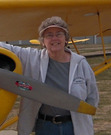Sarah Byrn Rickman's Blog, page 8
May 7, 2020
Yes, Mom Flew a Helicopter in the First Gulf War
“In Desert Storm, women were allowed to do combat support and combat service support,” Vicky Calhoun explained in last week’s Blog. “Then into the 1990s, the Air Force let women into fighter aircraft. That helped erode the Army argument that women couldn’t fly combat aircraft.
“Now women military pilots have flown combat aircraft—Apache and H-53 helicopters, A-10 Warthogs and F-16s—in the Second Gulf War and in Afghanistan.”
Vicky Calhoun wasn’t the first woman in an Army helicopter, though she was one of the earliest. How did she get along with the men with whom she flew?
“I Had 40 Fathers, They Took Care of Me”
“I once heard a woman speak on the four roles of women: daughter, wife, mother or sister. When I joined my Chinook unit in Germany, I was young, 24 years old. I was no threat to those seasoned men. The unit in Germany took me on as the daughter. I had 40 fathers. They taught me how to fly, and they took care of me.”
After serving 20 years, Calhoun opted for retirement in 2003, closing out her career as a lieutenant colonel assigned to the Pentagon. By then, most of the first wave of women military fliers had already retired, and now the second wave—Calhoun’s generation—was making the move as well.
In her second career, Calhoun became a government contractor, once again working almost exclusively with men. “I had the same struggles as a retiree that I did as a woman entering the military,” she said. “Proving myself. There aren’t many women doing this work.”
It’s been said the clothes make the man. Vicky Calhoun learned that, in her case, the clothes made the woman. And she learned that lesson well: “My uniform gave me credibility—my ribbons, my awards, my rank. All those things speak miles to people.
“I Had to Earn My Credibility All Over Again”
“I no longer wear a uniform. A woman in our culture has very little credibility when she walks in a room. Now I’m just another woman, not LTC Calhoun. The guys in my unit in the Army knew I would pull my weight. They trusted me. The corporate world is very different. It’s a new team and a new game. I started over, and I had to earn my credibility all over again.”
In April 2011, Calhoun joined the U.S. Army Cyber Command as a civilian employee. As Army Cyber organizations have evolved, today she belongs to the Cyber Center of Excellence. She is now involved in a new and different kind of combat: cyber warfare.
During flight school Calhoun joined the then fledgling Women Military Aviators (WMA) organization, formed in the early 1980s, when young women serving as military aviators needed a social and mentoring meeting ground. Seeking guidance, the new organization sought support from the Women Airforce Service Pilots (WASP) of World War II—the first women to fly Army airplanes. Together the two organizations got the fledgling group off the ground. After retiring from active duty in 2003, Calhoun took command of the WMA, serving as its president until 2007.
You’re In the Chinook Cockpit With Her
This writer had the good fortune to meet Vicky during her tenure as WMA president. I was invited to do a presentation at their annual meeting about my research and books on the WASP — the women pilots who helped found WMA. There, I heard Vicky speak about flying her Chinook in Desert Storm. I was spellbound. I was there in that Chinook with her.
Hers was one of the most riveting talks I have ever heard.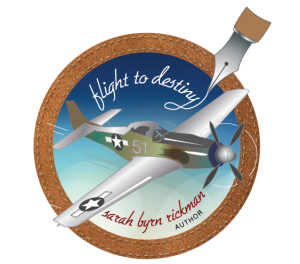
Much to my dismay, I did not have a tape recorder with me that day and sorely regretted not being able to
This three-part article is the result of her talk and of that interview, many years ago.
Twin Daughters Might Become Pilots Too
Yes, “Mom” did fly in Desert Storm. Vicky is the mother of twin daughters who are turning 13 this month.
Originally published in the March 2013 issue of Aviation History. To subscribe, click here.
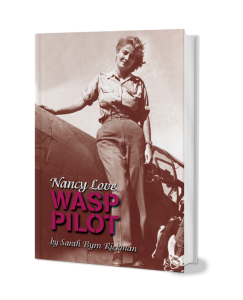 Sarah Byrn Rickman is the author of nine books about the WASP, with number ten due out later this year. She serves as editor of the official WASP newsletter. For more on the WMA, visit https://www.womenmilitaryaviators.com
Sarah Byrn Rickman is the author of nine books about the WASP, with number ten due out later this year. She serves as editor of the official WASP newsletter. For more on the WMA, visit https://www.womenmilitaryaviators.com
NEWS FLASH: Sarah’s most recent book, Nancy Love: WASP Pilot, is now available as an e-Book on Amazon. Check it out!
https://www.amazon.com/Nancy-Love-Sarah-Byrn-Rickman-ebook/dp/B087H2QX7Z/
The post Yes, Mom Flew a Helicopter in the First Gulf War appeared first on Sarah Byrn Rickman.
May 1, 2020
Mom Flew Helicopters in Desert Storm (Part 2)
Last week’s post concluded with these two paragraphs:
On January 15, 1991, the United Nations gave Saddam Hussein an ultimatum to withdraw from Kuwait. He didn’t budge, and on January 17, U.N. forces led by the U.S. attacked Iraq. Desert Shield had become Desert Storm, and a five-week air war ensued.
Calhoun, her crew and all of Alpha Company continued to watch and wait. On January 21, the 18th Aviation Brigade got the word to move by ground and air to set up near Rafha for the push north. Then on February 24, the ground war erupted, and Calhoun and the 18th went into action.
Capt. Vicky Calhoun Picks Up Her Story Here
“It was an air assault, not an airborne mission,” Calhoun explained. “In an air assault, we land the troops rather than drop them. Our whole battalion—40 CH-47Ds— provided support for the 101st Airborne as it began its attack. With us were Apaches, Cobras and Blackhawks. We began lifting the 101st into what became Forward Operating Base Cobra, 93 miles into Iraq and halfway to the Euphrates River.
“We flew more than 300 helicopter sorties, ferrying troops and equipment. It was the largest heliborne operation in military history.
“The mission was to reposition supplies to the north so that the 101st and the 82nd ground troops could move on Baghdad. We’d go up with the supplies and then come back to get more. We moved thousands of gallons of fuel in 500-gallon blivets* slung under our Chinooks.” * [Blivets, a military term for rubberized bladders used by various air forces for holding fuel at temporary locations, usually small airstrips. Once drained, the bags would go flat and be easily stored until required fair assaultor use elsewhere.]
“Our Sling Load Was 10 Feet Off the Ground”
“We flew at 120 knots—which is very fast and very dangerous—and our sling load was only about 10 feet off the ground.”
Asked whether they were shot at during those operations, Calhoun said: “At night, you can see the tracers. During the day you can’t really tell if you’re being fired on until it hits you. Ours was a daylight operation. Our routes were planned over unoccupied areas, where the ground troops had cleared the way.”
The peacetime crew of a Chinook is four: pilot, copilot, crew chief and flight engineer. But in Iraq they needed a fifth crew member, a door gunner.
“We Needed the Bravos — Trained Infantrymen”
“By then I had become the adjutant,”[personal assistant to the commander]. Calhoun recalled. “My job was to help the battalion commander with personnel and administrative problems. I thought we should bring in 11 Bravos [trained infantrymen] to ride that position rather than use our mechanics. We needed the mechanics fresh to work on the planes when they returned to base. The infantrymen were what we needed.”
Calhoun and her fellow Chinook pilots flew daytime sorties continuously during the 100-hour ground war. “We kept the daisy chain going,” she said.
A cease-fire was declared on February 28. The next day the battalion lost one of its seven women pilots, Major Marie Rossi, commander of Bravo Company, whose helicopter hit a microwave tower in northern Saudi Arabia.
“The Worst Moment of the War”
“The sun was setting and the crews were on the way back from their missions,” said Calhoun. “Dusk is a very dangerous time.” Of the crew of five, only the door gunner survived. For Calhoun, that was the worst moment of the war.
By March 5, it was all over—four days of combat and four days of aftermath. Having been in Saudi Arabia from the beginning, the 18th Aviation Brigade was among the first units to leave.
After Calhoun returned to Fort Bragg in April 1991, she had time to reflect on her experience.
“In 1989, the commander could handpick who went to Panama, and the women were not selected,” she noted. “A year later, in Desert Shield/Desert Storm, the whole unit went—the men and the women. Though women still were not assigned to combat units, that was a huge change.
Finally, the Women Were Flying
“Army women in Desert Storm flew utility and cargo aircraft. The women flying medevac helicopters were moving casualties. Several other women and I were flying the Chinooks on troop-carrying and supply runs. Air Force women flew tankers and transports, but not fighters and bombers.”
“Still, it was a beginning.
“It’s the demographics that are in our favor,” said Calhoun. “We have a volunteer Army now. Women are 50 percent of the population. If we’re going to bring in recruits at the volume we need, we have to open positions to women. It has to do with that, not gender.
“In Desert Storm, women were allowed to do combat support and combat service support. Then into the 1990s, the Air Force let women into fighter aircraft. That helped erode the Army argument that women couldn’t fly combat aircraft.”
Now Army and Air Force women have flown combat aircraft—Apache and H-53 helicopters, A-10 Warthogs and F-16s—in the Second Gulf War and in Afghanistan.
NEXT WEEK: Conclusion, Part 3
Sarah Byrn Rickman is the author of nine books about the WASP, and serves as editor of the official WASP newsletter. For more on the WMA, visit womenmilitaryaviators.org.:
Sarah’s books are on Amazon: https://www.amazon.com/s?k=sarah+byrn+rickman&i=stripbooks&ref=nb_sb_noss_1
Vicky Calhoun’s story originally was published in the March 2013 issue of Aviation History. To subscribe, click here.
The post Mom Flew Helicopters in Desert Storm (Part 2) appeared first on Sarah Byrn Rickman.
April 23, 2020
This Mom Flew Helicopters in Desert Storm
Army Chinook Pilot Looks Back on Her Service
Part I: The three part story of one Desert Storm helicopter pilot.
Captain Victoria Calhoun sat on the “ass end” of her CH-47D Chinook helicopter—parked nose to tail with Alpha Company’s other 15 choppers. The night was clear, the stars looked close enough to touch. As cold crept up the arms and legs and down the neck of her Army-issue flight suit, she drew her Army-issue blanket closer around her.
At 3 a.m., the deep-throated roar of F-15s firing up shook the night. Their rising thunder was matched by the rising flow of adrenaline coursing through the captain’s blood. Then came the takeoff blast as the jets roared skyward, their engines glowing. Hundreds of fighter-bombers were on their way to bomb Baghdad.
Desert Storm Had Begun!
“This is it,” Calhoun thought. “This is what I’ve been waiting for. This is why I’m here.” It was January 17, 1991, and the First Gulf War, Desert Storm, had just begun.
In 1980 Calhoun, a freshman at Mary Baldwin College, an all-women’s school in Virginia, signed up for Army ROTC through nearby James Madison University. Majoring in biology, she graduated in 1983 and was commissioned a second lieutenant. She entered the Army just as opportunities were opening up for women.
A flight school slot, followed by four years in Germany learning to pilot the Chinook in combat-support missions, earned Calhoun her captain’s bars. In 1989 came her hoped-for assignment to the home of the famed 82nd Airborne Division, Fort Bragg, N.C.
Fort Bragg Is Where It’s Happening!
“I wanted to go to Fort Bragg because if anything was happening, it was happening at Fort Bragg,” Calhoun said. She was assigned to the Battalion Operations Section as the training officer and assistant operations officer.
“We already had people down in Panama*,” she explained.
*[The United States Invasion of Panama, codenamed Operation Just Cause, lasted December 20, 1989 to January 31, 1990. Panamanian leader, general, and dictator Manuel Noriega was deposed citing racketeering and drug trafficking.] https://en.wikipedia.org/wiki/United_States_invasion_of_Panama
“The planes down there were C models. I had a lot of CH-47C model, night-vision-goggle time. Enough to be sent there—if I had been male. I volunteered repeatedly to go to Panama. What I didn’t know at that time was that my boss, the S-3 operations officer, didn’t want women to go.”
Wanted: Combat-Related Time and Experience
Like all soldiers, Calhoun was motivated by a desire to do the job, be part of the team and make a contribution. Advancement in the military is equated with combat-related time and experience. Women need it to move up in the ranks, just as the men do. The pathway up appeared to be blocked.
Then on August 7, 1990, Iraq’s Saddam Hussein invaded Kuwait.
“We got word the 18th Aviation Brigade was going to the Persian Gulf,” Calhoun said. “‘Are the women going?’ my boss asked. ‘Absolutely,’ the battalion commander said after a long pause. ‘We can’t do this without them!’ I sensed that, while we anxiously awaited his answer, he was mentally reviewing all the women and where they worked—including our battalion S-2 and me.”
Only a Handful of Women Helicopter Pilots
One of a handful of women helicopter pilots in the Army, this time Calhoun was going where the action was: “I was the first woman from the brigade into Saudi Arabia—13 days after the operation started. Our advance party flew in on a C-5 with two UH-1H Huey helicopters.
“When we got to Dhahran, the brigade commander had to negotiate with the Saudis to get our aircraft in there. Right then our helicopters were being disassembled back in North Carolina, put aboard ship and sent to the Persian Gulf by sea. We had to build a heliport for them, and to do that we had to show the Saudis how many planes were coming.
I drew a map and used paper cutouts of helicopters to illustrate the numbers. Then we began laying asphalt—three miles of it! When the planes arrived, we offloaded them, reassembled them and parked them on the new heliport. Chinooks take up a lot of space.”
Buddies: During Desert Shield, the Women Bonded
While the politicians played a global game of chicken, Calhoun and the rest of the Desert Shield brigade waited. November came and went. December segued into the New Year. And still they waited. Calhoun and six other women helicopter pilots who were sharing cramped quarters in a compound in Dhahran bonded. Like men have done over centuries of warfare, they became buddies in the traditional Army sense.
On January 15, 1991, the United Nations gave Saddam Hussein an ultimatum to withdraw from Kuwait. He didn’t budge, and on January 17, U.N. forces led by the U.S. attacked Iraq. Desert Shield had become Desert Storm, and a five-week air war ensued.
Calhoun, her crew and all of Alpha Company continued to watch and wait. On January 21, the 18th Aviation Brigade got the word to move by ground and air to set up near Rafha for the push north.
February 24 — the Ground War Was On!
On February 24, the ground war erupted, and the 18th went into action. Desert Shield was over. Desert Storm had begun.
*****
Continued next week —Part II.
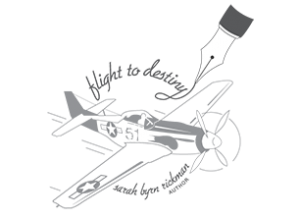
Sarah Byrn Rickman is the author of nine books about the WASP, the American women pilots who flew in World War II, and serves as editor of the official WASP newsletter.
This updated article originally was published in the March 2013 issue of Aviation History magazine. To subscribe, click here.
The post This Mom Flew Helicopters in Desert Storm appeared first on Sarah Byrn Rickman.
April 9, 2020
Sarah’s “Flight to Destiny” Now On Amazon Kindle
All of Pearl Harbor was spread out in front of Annie. The water itself appeared to be on fire. Japanese planes zoomed back and forth, diving, climbing, turning, shooting at everything that moved — planes, boats, trucks, cars, bicycles, people.
Recall Reading These Words Back in January?
They are from Chapter One of my award-winning WAFS/WASP novel Flight to Destiny. I posted the chapter in three parts in successive weeks in January. Thank you for your great feedback. It made me think about how I could make the book more accessible. Putting the novel into Kindle format on Amazon was the answer. So, it is done!
Reviews and accolades are a good thing. I’m hoping some of you will order FTD in Kindle. And, if you like it, please leave me a review. The more stars, the better!!! Here is what one of my woman pilot friends wrote about Flight to Destiny.
Strap Into Your Pursuit Plane and Prepare for Air Combat Maneuvering
“Our lead pilot (author) Sarah Rickman will be taking us on a fast-paced and historically accurate mission with the Women’s Auxiliary Ferrying Squadron (WAFS) of World War II. Along the way Sarah will introduce us to three fictional “wing-women” who will help us get inside the thoughts of the main characters in their history— Nancy Love and Jackie Cochran.
“Because I know the history of the WAFS, I originally thought it would be difficult to suspend disbelief of Sarah’s additional fictional characters. However, Sarah has developed them so they are superbly believable as young women and as aviators flying military aircraft in support of World War II. Sarah injects just enough realistic romance, plus relationship issues, to create well-rounded 20-something women who also happen to be patriotic, talented pilots.
Fictional Characters Add Another Dimension to the Story
“Through the eyes and hearts of the fictional characters, Sarah has creatively added dimensions to the main characters—Nancy Love and Jackie Cochran. Both have often been portrayed as one-dimensional (classy/crass, patriotic/ambitious, “for the common good”/ “my way or the highway”).
“For those who know the story, Sarah’s approach will add substance to the main characters, our role models. For those just beginning their journey learning about the WAFS, this entertaining approach will provide insight beyond the mere statement of facts regarding their incredible stories.
“Every time I read Romeo & Juliet or see it in theaters, I never give up hope for a different, more positive outcome. This story is much the same for me. Like Romeo & Juliet, I know the ending but I keep hoping that it will end differently—that the WAFS had continued flying for the military!
WAFS Are Role Models for Today’s Women Pilots
“In spite of how the real story ends, Sarah weaves an optimistic future for these World War II women aviators. They continued to contribute to our country’s success in many ways, including being role models for my generation of military women aviators and many generations to come. I hope she is setting the stage for a follow-on book to tell the post-WAFS story.
“Thanks to Sarah’s expertise both in subject knowledge and in storytelling, I now feel more connected to the main characters— Nancy Love and Jackie Cochran.
“Lead on, Sarah!”
Trish Beckman
Commander, US Navy (retired)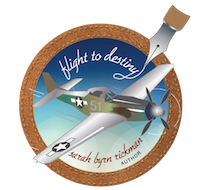
Flight to Destiny
WINNER:
2016 Eudora Welty Memorial Award, National League of American Pen Women, Inc.
2013 Book Competition, Greyden Press, Dayton, Ohio,
Grand Prize
Winner, Fiction.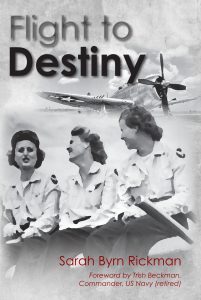
2000 Paul Gillette Winner for Historical Fiction Manuscript, Pikes Peak Writers Conference, Colorado Springs. Incidentally, Sarah’s first WASP Novel, Flight from Fear, won for Historical Fiction Manuscript at the 1999 PPW Conference, giving her back-to-back wins. Look for Flight from Fear in Kindle in the near future.
Good reading and Thank You for reading my blog!
The post Sarah’s “Flight to Destiny” Now On Amazon Kindle appeared first on Sarah Byrn Rickman.
March 13, 2020
Libraries Receive Aviation-Inspired Books for Girls in STEM
Amazing! That’s what these last few weeks have been to me. Any of you who follow my blog posts and biweekly newsletters — or who are in tune with me on Facebook — are somewhat aware of this. And my Colorado Springs friends who take The Gazette have seen it up close and personal!
Last Saturday, The Gazette ran a terrific article about my books, about me and about the work that I — with a lot of help from several friends and partners in this undertaking — have been able to launch. Now there’s this article in Editor Randy Loyd’s Chapter Newsletter for EAA Chapter 72, Meadow Lake Airport, Colorado Springs. He sent this out to the membership this week. (I am a member.) I’ve reprinted it here, with his permission. My grateful thanks to Randy and to the Chapter. And my heartfelt appreciation to Vann Norred of EAA 72 for jump-starting this incredible endeavor. Thanks Vann!!!
EAA Chapter 72 Newsletter Editor Writes:
EAA Chapter 72 and two chapters of the Ninety-Nines are working together to give Sarah Rickman’s two-volume young adult series, WASP Pilots to middle and high schools in the Colorado Springs area. We are proud to be working with the Rio Grande Norte and Fort Worth Chapters of the Ninety-Nines and Terry London Rinehart, BJ Erickson’s daughter on the project. Our first presentation was January 29 at Falcon High School where pairs of books were donated to the Falcon Middle School, Falcon High School and the Falcon Junior Air Force ROTC libraries. Our goal is to place 35 sets of these award winning books in local schools.
The second event took place on March 7 at the Mill National Training Center, a joint vocational education campus of Widefield District 3 and Peyton District 23. Educators from Sproul Junior High School and Widefield High School were present to receive the books for their libraries.
The National Aviation Hall of Fame (NAHF) awarded this recently published young adult series, WASP Pilots, their Combs-Gates award for 2019. The WASP Pilot series, written for readers age 10 and up, begins with two biographies, BJ Erickson: WASP Pilot and Nancy Love: WASP Pilot, chronicling women flying sophisticated Army airplanes in World War II, events in aviation history unknown by today’s youth. This series is intended to interest young girls in Science, Technology, Engineering, & Math (STEM) through these young women’s accomplishments in aviation.
More local schools will be receiving these books in their libraries soon. — Randy Loyd
Award-Winning Woman Pilot Biographies Aimed at Girls 10-14
What’s happening here in Colorado Springs is a direct result of yours truly (Sarah Byrn) being honored last October, winning the Combs Gates Award from the National Aviation Hall of Fame — for the second time. Thank you Amy Spowart, NAHF President and CEO, and staff and in particular the judges for so honoring me and my books BJ Erickson: WASP Pilot and Nancy Love: WASP Pilot.
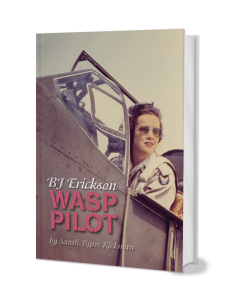 The Combs Gates Award, in NAHF’s own words, “is for projects that reflect an emphasis on the individual pioneers – the people – who defined America’s aerospace horizons.” Nancy Love and BJ Erickson are two such pioneers, remarkable in their accomplishments.
The Combs Gates Award, in NAHF’s own words, “is for projects that reflect an emphasis on the individual pioneers – the people – who defined America’s aerospace horizons.” Nancy Love and BJ Erickson are two such pioneers, remarkable in their accomplishments.
The NAHF’s goal is to broaden the  appreciation of the world of aviation and space to an ever-widening audience, specifically each younger generation as it evolves. In other words: our youth, today, tomorrow and beyond. They felt these two books — that show what a small group of skilled, innovative, and daring young women did when the opportunity to serve in World War II called — were worth advocating and endorsing.
appreciation of the world of aviation and space to an ever-widening audience, specifically each younger generation as it evolves. In other words: our youth, today, tomorrow and beyond. They felt these two books — that show what a small group of skilled, innovative, and daring young women did when the opportunity to serve in World War II called — were worth advocating and endorsing.
Who Is the Audience Here?
Up until now, I’ve written adult-focused (general audience) books. These two books are my initial entry into what is called, in the literary world, the Young Adult (YA) Market — books aimed at middle schoolers and, in my case, young high schoolers —roughly age 10 to 14. I know voracious 10-year-old readers on up can read, understand and appreciate what is contained in them. I was one of them many many years ago.
Frankly, the books also appeal to older teens and adults, because I REFUSE to write down to kids. These books are shorter, contain less supplementary material, are fast moving, and cover a specific and significant period in history. And, yes, they are about women— little known women who succeeded. Aviation terms are clarified. Most adults don’t have a working knowledge of the aviation lingo, let alone kids.
Young people today, young women in particular, need to know what forward-thinking, smart, confident women of the past have done. They are apt role models for today’s youth. But if nothing is known about them, a great opportunity is lost. Thus my books. Number three should be out this August. And two more wait in the wings for me to finish them.
My Thanks to the Ninety-Nines and the EAA!
My thanks to my Nines-Nines sisters in the Rio Grande Norte and the Fort Worth chapters and, as always, Terry Rinehart — BJ’s daughter — (both Ninety-Nines) who has been with me in this endeavor from the beginning. They bought half of our give-away books and EAA Chapter 72 bought the other half. Let me add: my own Ninety-Nines chapter — our local Pikes Peak Ninety-Nines — gave away 15 copies of these books at a Girl Scout Patch Day held at the Colorado Jet Center last October. Thanks to Chair Di Gillings and the rest of the gang!
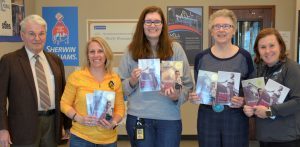 Here are some photos from our day at the Mill National Training Center, a joint vocational education campus of Widefield District 3.
Here are some photos from our day at the Mill National Training Center, a joint vocational education campus of Widefield District 3.
Left to right: Vann Norred, Kristie Martinez & Anna Gordon (Sproul Junior High School), Author Sarah Byrn Rickman, and Amy Hawkins (Widefield High School.)
Order BJ Erikson: WASP Pilot:
https://www.amazon.com/BJ-Erickson-Pilot-Sarah-Rickman/dp/0865412472/
Order Nancy Love: WASP Pilot:
https://www.amazon.com/Nancy-Love-Sarah-Byrn-Rickman/dp/0865412553/
Thanks for reading my Blog! SBR
The post Libraries Receive Aviation-Inspired Books for Girls in STEM appeared first on Sarah Byrn Rickman.
February 21, 2020
Bessie Coleman, America’s First Black Aviatrix (Woman Pilot)
Black History Month, February 2008, my daughter-in-law asked me to suggest a notable African American woman on whom my granddaughter, Katie, might do a report for her kindergarten class.
(Bessie Coleman’s photo courtesy the Ninety-Nines Museum of Women Pilots, Oklahoma City)
I didn’t have to think twice. “Bessie Coleman.”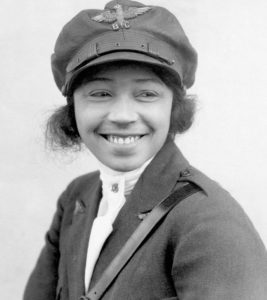
“Tell me more,” she said. And I did.
In 1986, a small museum opened in my home community of Centerville, Ohio, a suburb of Dayton. Because I was the editor of the local newspaper, the women behind that museum came to me for publicity about IWASM, the International Women’s Air and Space Museum.** That “encounter” changed my life.
IWASM and Joan Hrubec Were My Teachers
Four years later, I went to work for IWASM and began to learn “the story” of America’s pioneering women pilots. Having read about Amelia Earhart at age 13, I now learned about the women who preceded Amelia, and those who followed her.
My teacher was IWASM’s able administrator, Joan Hrubec. Joan was an avid pilot and a member of the Ninety-Nines, the Organization for Women Pilots. Given her vast knowledge of aviation’s pioneering American women, Joan taught me well. That I was a willing sponge didn’t hurt.
Katherine Wright, Orville and Wilbur’s sister — though never a pilot herself — became the first woman to fly in an airplane. In 1908, she flew in two exhibitions with Wilbur in France. The first women pilots followed soon after: Blanche Stuart Scott, Harriet Quimby, Katherine and Marjorie Stinson, Ruth Law, Neta Snook (who later taught Earhart to fly) and more.
And Joan introduced me to Aviatrix Bessie Coleman, who learned to fly in 1921.
Aviatrix = Woman Pilot
Being a woman and wanting to learn how to fly in early 20th century America was difficult enough. Bessie Coleman was not only a woman, she was a Black woman. In 1920, when she sought someone to teach her how to fly, no one would take her on as a student.
Born in Texas, Bessie by then lived on Chicago’s south side. She was an accomplished manicurist. When Robert Abbott, editor-publisher of the Chicago Defender newspaper, met Bessie he was impressed by her drive “to be someone.” Abbott had established his newspaper to gain recognition for Black Americans. He understood her dream of becoming a pilot and told her she needed to go to France to learn to fly. The French, he pointed out to her, were not racist.
Bessie went to France. There, she learned to fly in a French Nieuport 82 biplane. It was described as “a fragile vehicle of wood, wire, steel, aluminum, cloth, and pressed cardboard.” It was similar to the Curtiss JN-4 — better known as “the Jenny” — a favorite for flight instruction in America in the 1920s.
Bessie and the All-Important Pre-Flight
One of the first things a new flight student learns is to give the airplane a thorough “pre-flight”, a walk-around, close inspection before taking off.
Author Doris Rich writes in Queen Bess, Daredevil Aviator: “Each time she took a lesson in the Nieuport, Bessie had to inspect the entire plane first for possible faults — wings, struts, wires, cloth covering, engine, propeller, cowling, and the four-wheel landing gear with pneumatic tires. Planes in those days had no steering wheel or brakes. The steering system consisted of a vertical stick the thickness of a baseball bat in front of the pilot and a rudder bar under the pilot’s feet.”
In trainer airplanes like the Nieuport and the Jenny, the student and the instructor sit in identical cockpits — one behind the other — each with an identical set of controls. Because of the noise from the engine, Bessie could not hear what the instructor was telling her to do. So she learned to fly “by watching her stick and rudder bar move as the instructor moved his. Soon she was placing her hands on the stick and her feet on the rudder bar, enabling her to get the feel of what he was doing.”
Bessie Earns Coveted FAI Pilot’s License
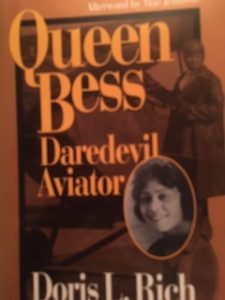
Bessie earned her pilot’s license on June 15, 1921, from “France’s most famous flight school, École d’Aviation de Frères Caudron.” She qualified for the license issued by the renowned and most prestigious French Fédération Aéronautique Internationale (FAI), “the only organization at the time whose recognition granted one the right to fly anywhere in the world.”
Bessie returned home and began to make a name for herself in the aviation-crazy world of 1920s America. It was not easy, but Bessie was a fighter. She became one of America’s famous daredevil barnstormers, traveling around the country flying acrobatic stunts in the earliest air shows. And the rest, as they say, is history.
Quotes etc. in this Blog are taken from pages 29-34 of Queen Bess, Daredevil Aviator , by Doris L. Rich, 1993.
Katie Gave Her Report on Aviatrix Bessie Coleman
Back to Katie. I ordered Nobody Owns the Sky: The Story of “Brave Bessie” Coleman, a children’s book by Reeve Lindbergh (Charles Lindbergh’s daughter) and illustrated by Pamela Paparone. Amazon delivered it to Katie on February 18, 2008. A few days later, she stood up in front of her class and told them about “Brave Bessie.” She wore the flight suit I had bought for her at the Women in Aviation conference, and a borrowed cloth flying helmet and goggles. I can’t find the photo or I would include it here. That day, a bunch of Atlanta, Georgia, kindergarteners learned about the first Black woman to earn her pilot’s license, the barnstorming daredevil Bessie Coleman.
There are numerous books about Bessie Coleman. To read more about this gutsy pioneer aviatrix, visit your local library, or look online for the selection of biographies about her, including:
Nobody Owns the Sky: The Story of “Brave Bessie” Coleman
https://www.amazon.com/Nobody-Owns-Sky-Bessie-Coleman/dp/0763603619/
Queen Bess, Daredevil Aviator
https://www.amazon.com/gp/product/1560986182?pf
**The International Women’s Air and Space Museum is now located in Cleveland, Ohio, at Burke Lakefront Airport.
The post Bessie Coleman, America’s First Black Aviatrix (Woman Pilot) appeared first on Sarah Byrn Rickman.
February 13, 2020
The WASP: A WWII Mini-History
In early 1942, as America struggled to arm itself for World War II, the leaders of the Army Air Forces knew that air power — superiority in the air — was crucial to winning. Unfortunately, we didn’t have nearly enough planes with which to fight — nor enough pilots to fly them when we had them.
Aircraft in which to train new pilots were on the way. Men were 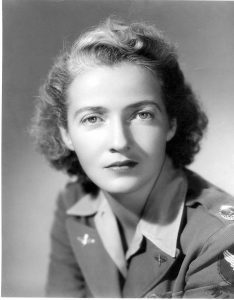 signing up to learn to fly them. But when those new training aircraft rolled off the factory assembly lines, there was a problem. No qualified pilots remained available to deliver them to the training fields. Every qualified U.S. pilot was by then engaged in some phase of combat-related flying or preparation.
signing up to learn to fly them. But when those new training aircraft rolled off the factory assembly lines, there was a problem. No qualified pilots remained available to deliver them to the training fields. Every qualified U.S. pilot was by then engaged in some phase of combat-related flying or preparation.
All the Male Pilots Had Gone to War
Finding men to “ferry” [fly] these trainers to the flight schools proved difficult.
Twenty-eight experienced civilian women pilots volunteered to do the job. They ferried the trainers to the training fields. Recruited by well-known and respected woman pilot Nancy Love [right], they formed the country’s first female squadron in September 1942. Known as the Women’s Auxiliary Ferrying Squadron or WAFS, they flew for the Ferrying Division, Air Transport Command.
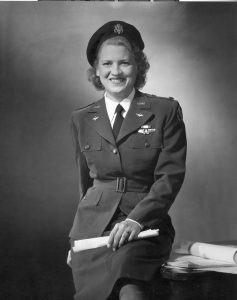 Between November 1942 and December 1944, through the efforts of Jacqueline Cochran [left], another well-known woman pilot of the day, 1,074 more women were trained to fly “the Army way” — first in Houston, then in Sweetwater, TX.
Between November 1942 and December 1944, through the efforts of Jacqueline Cochran [left], another well-known woman pilot of the day, 1,074 more women were trained to fly “the Army way” — first in Houston, then in Sweetwater, TX.
The women from the earliest classes went to Nancy Love’s WAFS squadrons upon graduation. There, they ferried increasingly bigger, more powerful aircraft. Graduates of the later classes relieved male pilots of all sorts of flying jobs so they could be assigned elsewhere. Some called them “dishwashing jobs.” Why? They were the jobs the men didn’t want. The men wanted the glamorous jobs — flying fighters and bombers! Women just wanted to fly, period!
WASP Stationed at 120 Bases
As women pilots took on these assignments, the efforts of Love and Cochran released an equal number of male pilots to be sent to combat-related assignments. Women pilots eventually served at more than 120 bases around the country.
In August 1943, the WAFS and the women in training in Texas all became known as the WASP — Women Airforce Service Pilots — under Cochran’s command. Nancy Love continued to lead the WASP of the Ferrying Division.

Over their two-plus years of service, the WASP, collectively, flew every aircraft in the Army’s World War II arsenal. In addition to ferrying, they towed gunnery targets. Gunnery recruits firing at them used live ammunition. The WASP transported equipment and nonflying personnel. They flight-tested aircraft that had been repaired — before the men were allowed to fly them again. Some became instrument flight instructors. Many flew copilot in twin-engine aircraft, freeing a male co-pilot to be used elsewhere.
[ https://www.amazon.com/Nancy-Love-Sarah-Byrn-Rickman/dp/0865412553/ ]
By late 1943, trainer aircraft no longer were needed. The factories now turned out high-performance fighter aircraft, known as pursuits. Versatile aircraft, they could protect our four-engine bombers on long-range bombing runs over Germany. The more experienced of the WASP ferry pilots went back to school to learn to fly those pursuits. Delivering single-engine, one-pilot cockpit pursuits to the docks for shipment abroad became the women ferry pilots’ top priority job.
Generals Tunner, George and Arnold Supported WASP
The men who championed Love and the WAFS were Ferrying Division commander General William H. Tunner and his boss, General Harold George, Air Transport Command. Army Air Forces Commanding General “Hap” Arnold supported and approved Cochran’s idea to train women pilots for many flying-related jobs.
Arnold was revered by the U.S. Congress, which was known to give him everything he asked for to fight the war. But in June 1944, when he sought to officially designate his WASP members of the United States military, Congress said “no.” Disgruntled male pilots had complained loudly that women were taking their jobs. The press took up that issue and tried to smear the women pilots. The women remained civilians.
Like the men, WASP flew whatever they were asked to fly. Like the men, they dealt with balky aircraft, malfunctioning equipment and occasional deadly crashes. Thirty-eight died flying for their country. But the military took no responsibility for them. Classmates or squadron mates chipped in to ship their bodies’ home.
When a WASP Died, Mom’s Window Held No Gold Star
Throughout the program, the WASP received no medical care and no insurance benefits. No Gold Star graced the family’s window if their daughter died flying for her country. No burial subsidy. No flag on the coffin. Militarization would have remedied those inequities, but it didn’t happen.
The WASP were disbanded on December 20, 1944, and sent home with no recognition. Victory was in sight, and the women pilots were expendable.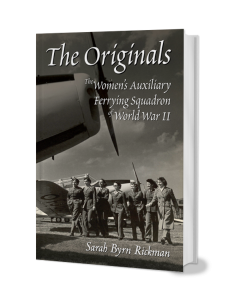
Unheralded and unappreciated, 1,102 Women Airforce Service Pilots flew wingtip to wingtip with their male counterparts, contributing significantly to the overall effort to win World War II.
I hope you have enjoyed my mini-history of the WASP. All my books can be found on Amazon. Links to three of them are shown here. SBR
https://www.amazon.com/Originals-Womens-Auxiliary-Ferrying-Squadron/dp/194509138X/ref=sr_1_fkm
https://www.amazon.com/s?k=wasp+of+the+ferry+command&i
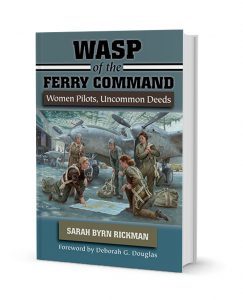
The post The WASP: A WWII Mini-History appeared first on Sarah Byrn Rickman.
February 7, 2020
iHeart Radio Interview: Moments with Marianne Show
Tune into the Moments with Marianne Show on Saturday, February 8th at 8pm EST/5pm PST for my interview about my #book, Nancy Love: WASP Pilot.
Heard on iHeartRadio! Click here to Listen LIVE http://tinyurl.com/iHeartRadioMwM OR download the Moments with Marianne show app on iTunes & Google Play!
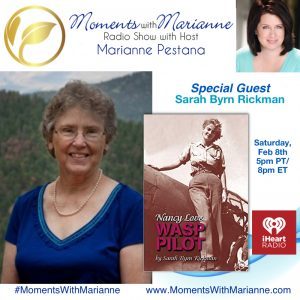
The post iHeart Radio Interview: Moments with Marianne Show appeared first on Sarah Byrn Rickman.
January 24, 2020
FLIGHT TO DESTINY— Sarah’s 2nd Novel, Part 3
Conclusion
All of Pearl Harbor was spread out in front of Annie. The water itself appeared to be on fire. Japanese planes zoomed back and forth, diving, climbing, turning, shooting at everything that moved — planes, boats, trucks, cars, bicycles, people.
Please don’t let them come after me, Annie thought, as she came out in the open — once more a target. I’m small potatoes compared to those battleships and destroyers. A stab of guilt caught in her stomach. She knew some of the officers on those embattled ships.
The gravel northeast to southwest runway in her sights,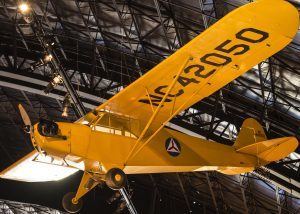 she dropped even lower and swung in an arc keeping the airplane below the horizon — the rounded line drawn by the crests of the hills — hoping a Jap Zero would not see her. A bright yellow aircraft was easy to spot on a sunlit morning. She said a silent prayer as she throttled back and prepared to land.
she dropped even lower and swung in an arc keeping the airplane below the horizon — the rounded line drawn by the crests of the hills — hoping a Jap Zero would not see her. A bright yellow aircraft was easy to spot on a sunlit morning. She said a silent prayer as she throttled back and prepared to land.
RUNWAY STRAIGHT AHEAD
No landing pattern for her this time. She’d be a sitting duck for some trigger-happy Jap pilot who might decide a pretty little Cub would be an extra trophy to brag about. Setting up a straight-in approach and totally disregarding wind direction, Annie aimed the little airplane straight at the runway.
She stayed only high enough to clear a couple of outbuildings and the vegetation that lay at the near end of the runway. Then she cut the throttle, pulled back on the stick, executed a flawless flare, and stuck the wheels solidly onto the runway.
“Greased it,” she shouted, triumphant in her power of concentration. Not touching the brakes, she taxied the plane full speed along the runway toward the hangars in the distance. A shadow crossed over her like a vulture looking for its dinner. She saw the silver and black gas-powered, prop-driven bird streak ahead. Almost in slow motion, the climbing fighter wheeled 180 degrees and started back toward her, flying low.  Now Annie hit the brakes, swerving for the side of the runway where high grass and a stand of palm trees grew. The little Cub slowed and stopped.
Now Annie hit the brakes, swerving for the side of the runway where high grass and a stand of palm trees grew. The little Cub slowed and stopped.
“RUN FOR IT!”
“I see him,” Tom Witten shouted back. They scrambled from the plane and ran for the side of the runway. Bullets beat a tattoo sending gravel flying, caught and ripped the fabric airplane to shreds in a split second. Annie and Tom dove for the high grass.
The Jap plane flew off down the end of the runway. Annie — the sharp-bladed grass had lacerated the side of her cheek where she lay — watched it bank and begin to turn again. “He’s coming back.” She got up and started running for the cover of palm trees twenty feet away. She heard Tom Witten breathing hard behind her.
Annie reached the palms as the plane came at them again — so close. When she looked over her shoulder, she saw the goggles and leather helmet and, she swore, a grin on the pilot’s face.
She tripped as bullets thudded into the ground behind her. She fell forward into the trunk of a palm, striking her head. Blood-red cobwebs pulsed and threatened to cover her eyes.
WAS HE COMING BACK?
She lay there, stunned, head throbbing. The inferno that was now Pearl Harbor still roared in her ears, but close around her there was not a sound. No airplane. No buzz of a homicidal Zero searched her out. Shaking her head, the cobwebs receded. She lay face down under the stand of palm trees. Her face and head bleeding, and her body, encased in flight coveralls, bathed in sweat. But she felt cold.
“We made it,” she said triumphantly, finally getting some semblance of control over her trembling body. “We made it!”
She pushed herself upright with hands and arms that didn’t feel like hers and twisted around into a sitting position where she could see back to the runway, the ruined airplane, and the firestorm that engulfed what had been a beautiful harbor.
Tom Witten lay face down just beyond the circle of sheltering palms.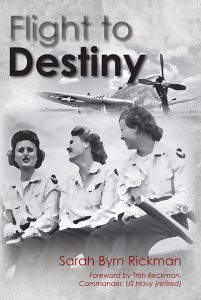 The back of his white T-shirt oozed pools of red.
The back of his white T-shirt oozed pools of red.
Annie stared as comprehension seeped into her brain and an overwhelming sadness crept into her heart. She dropped her head back to her knees, let out a shudder and then a sob and began to rock back and forth, her body racked with uncontrollable spasms.
Thanks for reading the first chapter from Flight to Destiny, 2016 winner of the Eudora Welty Memorial Award, the National League of American Pen Women, Inc.
To read Part 1, click here
To read Part 2, click here
To order Flight to Destiny: Click here
The post FLIGHT TO DESTINY— Sarah’s 2nd Novel, Part 3 appeared first on Sarah Byrn Rickman.
January 16, 2020
(More) FLIGHT TO DESTINY, SARAH’S 2nd WASP NOVEL
Attack on Pearl Harbor, December 7, 1941
CHAPTER ONE ( PART 2)
The airport lay right next to the harbor.
Tom tapped her shoulder, his mouth next to her ear so she could hear him. “Who were they, Miss Gwynn? Why d’ya suppose he shot at us?”
“Japanese. Trying to kill us. Damn near succeeded.”
Cornelia? She hadn’t seen her friend’s plane since before she spotted the Japanese formation. Again, Annie scanned the sky for the other yellow airplane. The blue expanse above and around her appeared as empty of airplanes now as it had been full just moments earlier.
CUB VS. JAPANESE ZERO, NO THANKS!
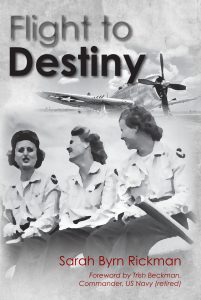
Hopefully, Cornelia had landed safely. Besides, Annie had other worries right now. She had an airplane and a student she needed to get home safely. If that fighter came back looking for her, he might bring a couple of his buddies along. A 50-horsepower Cub against high-speed Japanese warplanes. No thank you! She didn’t like those odds one bit. That he had missed her the first time and not stayed around for the kill constituted a major miracle. He wouldn’t miss a second time.
Maybe she should fly to the other side of the island. But land where? Eventually, she would run out of fuel. No, she had to get back to Rodgers.
Blood still pounded in her ears, reminding Annie that she and her student had barely escaped that encounter with their lives. But hot on the heels of the fear, yet another emotion welled inside her. It was vaguely familiar, yet far more intense than she had ever felt before.
Too tall and awkward as a child, she discovered acting the part of daredevil blunted the teasing inflicted by the other children. At age eight, she rode her bike at breakneck speed off a crudely constructed ramp and jumped Overall Creek. The split second she hung suspended over the water electrified her inner core. “I’m flying,” raced through her mind.
SOMETHING SHE WAS GOOD AT
She crashed in a heap on the far side, but outdistanced even the most athletic boy in the forbidden competition. A broken collarbone and a new respect from the boys and girls she played with were her tangible rewards. Deep within came the realization that, finally, here was something she could be good at.
When the government-subsidized Civilian Pilot Training Program (CPT) opened to college women in 1939, nineteen-year-old Annie, a junior at the University of Tennessee, signed up immediately. She was the first girl admitted to the program that allowed one woman for every nine men enrolled in a class.  When the bi-wing trainer lifted off the ground with her in the back seat — the pilot’s seat in the tandem cockpit — she knew she had forever left behind life as she knew it.
When the bi-wing trainer lifted off the ground with her in the back seat — the pilot’s seat in the tandem cockpit — she knew she had forever left behind life as she knew it.
With danger distinctly absent from that tame, twenty-minute introductory flight — the instructor let her fly straight and level and handle the stick and rudders for two sweeping one-hundred-eighty degree turns, one in each direction. Annie still reveled at being thrust into a new dimension. Time stood still — ceased to exist, other than the time spent in the air when she was one with the airplane, the sky, the universe. That an error in her judgment could one day send her hurtling earthward never occurred to her. That engine failure or myriad other mechanical problems inherent in flying above the earth could send her into an uncontrollable flat spin — the death spin that resulted in inevitable oblivion — was worth the risk.
LIVING ON THE EDGE!
Now she would do anything to capture again — and again, and again — that rush that awaited the moment the wheels left the ground and the little airplane surged upward to become one with the sky. That moment when the craft no longer belonged to the earth, held back by such puny notions as human frailties, family allegiances, worldly pursuits like school and job. Flying meant living on the edge.
And Annie liked living on the edge, something hard to come by in her sheltered, Southern middle-class life.
Now, once again in the skies over Oahu, she came face to face with the knowledge that danger made her feel very much alive. No matter how bad, she had to see, wanted to see, what was happening beyond those mountains, back at Pearl.
“We’re going home,” she shouted over her shoulder to Tom, pleased at the measured composure she heard in her voice. Already the rapid heartbeat had slowed, her breathing returned to normal, the electric charge of danger replaced by an almost eerie calm. She checked the altimeter and her airspeed and pushed the throttle back to full. “Keep your eyes open for planes — any planes — tell me the minute you see one.”
MOLTEN METAL AND BURNING SHIPS
Annie flew lower than usual, dropping down just above the treetops as she made her way between two hills. When they came through the gap, she saw flames towering higher than a five-story building and leaping from listing ships in the middle of the harbor. Smoke billowed wherever she looked. Plumes of water from fire hoses shot skyward then fell as millions of droplets, only to be turned to steam when they contacted the molten metal of the burning ships that lay dying amidst what had been the United States’ Pacific fleet.
Want to know what happens to Annie and Tom?
Stay tuned. The final section of Chapter One is coming next Friday, January 24.
To order Flight to Destiny: https://www.amazon.com/s?k=Flight+to+Destiny
See my other books on Amazon as well.
The post (More) FLIGHT TO DESTINY, SARAH’S 2nd WASP NOVEL appeared first on Sarah Byrn Rickman.

